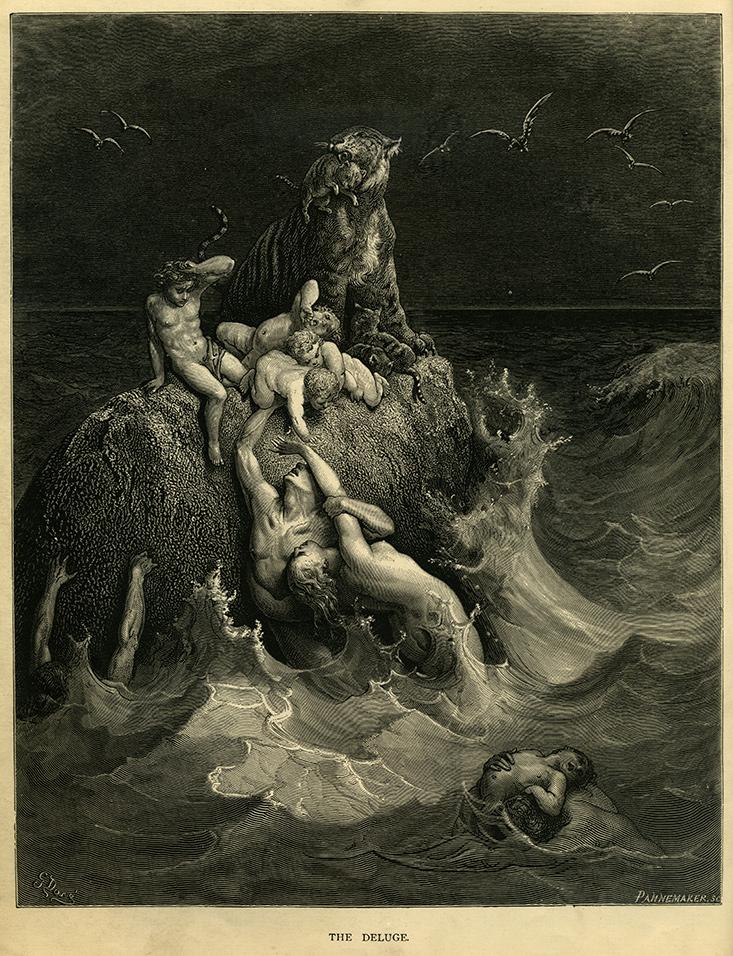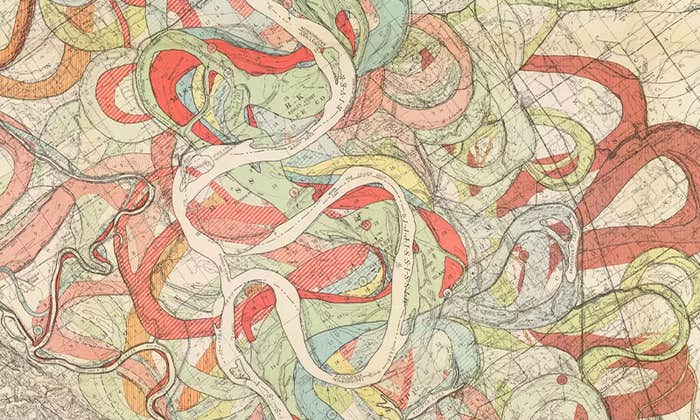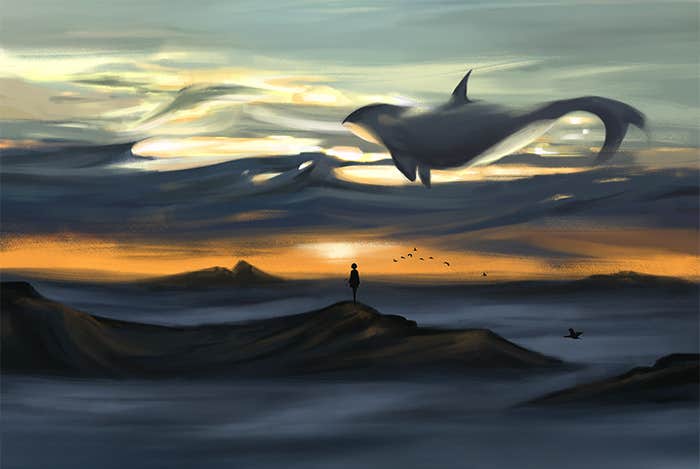I came to Tibet in the spring of 2002 to investigate a geologic mystery: How had the mighty Tsangpo River cut through the rising Himalaya to carve the deepest gorge in the world? Origin questions like this one fascinate me. I’m a geomorphologist—I study landforms and construct scientific narratives to explain the evolutionary processes that created and molded them. For years, I believed that my stories stood apart from myth in that they were forged in the topography of real landscapes—in the shape of hills to the lay of valleys. But that was before I visited the Tsangpo.
From the airport in Lhasa, my colleagues and I drove southeast, up and over an icy pass that descended into a tributary. As we wound our way toward the main river, I was surprised to see a series of flat surfaces perched, like a giant’s banquet tables, above the bottom of the valley. Known as terraces, these enormous piles of loose sediment commonly form when a river slices into its bed, leaving older, higher floodplains behind. But many of the terraces I now beheld were capped in alternating layers of silt and clay. Such fine, orderly strata would never settle out in a turbulent mountain river like the one beside us. What were these quiet-water deposits doing in an alpine valley at the top of the world?
Bouncing in the back of our Land Rover, I kept careful track of the terraces, marking their elevations on topographic maps. I noticed that at some point downriver, they all rose to roughly the same contour and then stayed at that elevation on down the valley, growing progressively taller as the river dropped lower and lower. Days later, when we visited the confluence where this tributary entered the Tsangpo, the terrace tops stood hundreds of feet above the valley floor.
Out of this landscape-scale jigsaw puzzle, a picture took shape: An ancient lake had once submerged the Tsangpo and its tributaries. Rivers emptying into the lake had deposited deltas, stacking sediments into layered terraces that today record the lake’s timeworn shorelines. There was just one missing puzzle piece: What had kept all of that water from draining down the Tsangpo gorge?
Could these two stories—one cast in culture, the other written on land—be telling different versions of the same affair?
At the head of the gorge (which at its deepest depth drops the river almost 20,000 feet below the surrounding peaks), we found the eroded remnants of a glacial moraine—dirt and rocks pushed downhill by flowing ice. Debris appeared on both banks of the Tsangpo, indicating that a glacier advancing down the flanks of a nearby mountain had bulldozed a colossal dam of earth and ice over the river. The barrier had sealed off the valley, and the river had swelled to form a massive lake. But the water-worn form of the moraine told us that the dam hadn’t lasted. When it broke, a wall of water raged down the steep, narrow gorge at hundreds of millions of gallons per second—surpassing the discharge of the Amazon.
This discovery was electrifying. In reading the land, we had unearthed a grand geological saga long lost to history. Or so we thought. One day, as we bumped along past a small peak ringed by terraces, one of my graduate students told a story he’d read in a guidebook. The peak, he said, marked the site of a kora—a Tibetan Buddhist pilgrimage—commemorating how the spiritual teacher Padmasambhava, also known as Guru Rimpoche, brought Buddhism to Tibet. According to legend, Guru Rimpoche converted the people from animism through a series of miracles, which included defeating a demon who dwelled in a great lake. How did the guru beat the demon? He drained its lake.
Guru Rimpoche came to the Tsangpo in the eighth century, around the time the ancient lake we had just stumbled upon filled the valley, according to radiocarbon tests of charcoal bits collected from the terraces. I pondered these two stories—one cast in culture, the other written on land. Could they be telling different versions of the same affair?
The late geologist Dorothy Vitaliano coined the term geomythology in the 1960s to describe oral lore that explains peculiar landforms or references geological cataclysms—earthquakes, fires, floods, volcanic eruptions, diverted waterways, or the sudden emergence or disappearance of islands. Like most geologists, I once dismissed these accounts as imaginative fantasies. Embellished with supernatural details and shrouded in the language of myth, they rung no truer than science-fiction yarns about Martian colonies and cyborg races. There is some evidence, however, that many geomyths are in fact grounded in events that actually happened.
The story of the great flood is one of the oldest and most widely told. A version of this legend appears in so many cultures that some pseudoscientific theorists have invoked its ubiquity as evidence of a global flood. But while flood myths share common elements—catastrophic inundation; a harrowing escape, usually by boat—the nature of the deluge varies from region to region. And the differences are telling. Often, the features of a fabled flood bear a striking resemblance to local geological processes, suggesting that many myths record real catastrophes witnessed in antiquity.
Although the lama lacked the tools and training of a modern scientist, his quest to understand the world was not so different from mine.
Flood stories from coastal settlements, for instance, such as in Fiji and Tahiti, tell of giant waves that struck from the ocean without warning or rainfall. A prehistoric tale from central Chile depicts two powerful serpents that vie to lift the sea the highest, inciting an earthquake and flooding the shore. In the American Pacific Northwest, native tribes tell of epic battles between Thunderbird and Whale. Again and again, the winged being grabs the sharp-toothed monster out of the water and then drops it, rousing enormous waves that sweep canoes into treetops.
These reports sound a lot like tsunamis. Indeed, thanks to Japanese temple records, we know that a major earthquake struck the Pacific Northwest on Jan. 26, 1700, sending waves as far as Japan. About that time, according to archaeological remains, Native Americans abandoned villages along the western coast of North America, from British Columbia to Oregon. In the myth of Thunderbird and Whale, survivors apparently preserved the memory of this or earlier tsunamis that drove them from their homes.

Similarly, inhabitants of the Arctic and high alpine regions, like the Tibetans of the Tsangpo valley, have retained flood myths that seem to describe glacial dam breaks. Norse mythology, for example, recounts how Odin, the “allfather” of gods, and his brothers killed the ice giant Ymir, whose blood, made of water, gushed forth in a deluge that drowned men and animals. Connecting this fantastical tale to an historical act is fraught with speculation. But I’d be surprised if Ymir wasn’t born out of an actual ice-dam rupture as glaciers retreated from Scandinavia at the end of the Pleistocene.
A third category of flood stories reflects the experiences of river communities, who speak of perpetual rains and slowly rising waters. The biblical story of Noah, from the Book of Genesis, is the iconic example. This Hebrew myth has roots in an older Mesopotamian tale recorded, in blocky cuneiform runes, on a fragmented clay tablet excavated from the ruins of an ancient library. The inscription portrays a righteous man who receives a divine warning of an impending flood intended to destroy humanity. He is ordered to build a vessel—an ark—and bring his family and animals aboard to ride out the storm.
I began to see science and mythology as two faces of the same coin.
There may be geological truth behind this tale, too. It’s possible, for instance, that heavy rains swelled the Tigris and Euphrates rivers enough to breach their levees, filling the lowlands like a bathtub. Columbia University oceanographers Bill Ryan and Walter Pitman came up with another hypothesis in the early 1990s. Analyzing sediment cores from the bed of the Black Sea, they discovered that before 5600 B.C., the sea was a large freshwater lake. Then, when glacial ice melting off the poles raised sea levels worldwide, the Mediterranean overtopped a narrow strip of land and decanted into the lake. The inflow “roared and surged at full spate for at least three hundred days,” the researchers write in their book Noah’s Flood, cascading over the land at 200 times the flow of Niagara Falls.
Ryan and Pitman speculate that this spillage rapidly inundated a broad plain where some of the world’s earliest farming communities lived. Perhaps, they offer, traumatized survivors fled to Mesopotamia, bringing with them knowledge of agriculture and irrigation—and a story about a great flood that submerged their world.
When I returned to the Tsangpo valley in 2004 on another research expedition, I told a local farmer that our team had found geological evidence of an ancient flood that drained a lake where her village now stood. Yes, she replied, she knew about the flood. The lamas at the local temple taught that when the lake emptied, it exposed flat, fertile land for her people to farm. She pointed halfway up the valley wall. There, she told me, the falling water had stranded three boats.
My colleagues and I decided to visit the lamas. Their temple sat high above the valley bottom on a lake terrace. In a colorful fresco on the temple wall, Guru Rimpoche hovered resplendently above a lake-filled valley. When we asked about the flood, the head lama listened patiently and then dismissed the event as old news. But he was curious about another geological puzzle: Why, he wondered, could one find water-rounded rocks on nearby mountainsides? Did their presence not prove that an ocean once covered Tibet’s tallest peaks?
As a geologist, I know that his theory wouldn’t hold up to scientific scrutiny. More likely, the smooth rocks were cobbles, stranded high on the valley wall when ancient rivers discharged into a glacier-dammed lake. Yet the lama’s profound interest in and attention to the details of the landscape struck me. Although he lacked the tools and training of a modern scientist, his quest to understand the world was not so different from mine.
I began to see science and mythology as two faces of the same coin. After all, the divide between these fields is a relatively recent development. Historically, they weren’t so easily teased apart.
Take the story of Noah. Early natural philosophers’ belief in a global flood colored their interpretations of worldly phenomena even as they laid the foundations for modern geology. Saint Augustine, a fourth-century bishop in a Roman province of Africa, warned against readings of the Bible that conflicted with reason and the study of nature. In his view, the earth didn’t lie. When he found seashells encased in mountain rock, he took them as confirmation of a global flood. How else could the bodies of marine creatures get locked up in mountaintops?

Nicolaus Steno, a Danish natural philosopher living in 17th-century Italy, likewise relied on field observations to uphold the truth of the biblical flood. While dissecting the head of a great white shark, he noticed that its teeth were precisely the size and shape of mysterious triangular objects in rocks known as tongue stones, which today we know are fossilized shark teeth. To explain how these teeth got into rocks, Steno reasoned that after Creation, the earth settled out of a primeval sea in layers, with the oldest layers on bottom and the youngest on top. Now known as Steno’s Law of Superposition, this rule became the foundational principle of geology. Steno used it to deduce that earth history involved six stages—one of which was Noah’s flood.
Gradually, however, the ties binding biblical narratives and geological science began to unravel. Steno showed that rocks could tell their own stories, thereby guiding, constraining, and ultimately refuting religious doctrine. Subsequent generations of geologists and paleontologists established that the history of our planet, and its flora and fauna, was much too long and complex to map neatly onto a literal interpretation of scripture. By the time Darwin published his controversial ideas on evolution, the geologically literate clergy had largely abandoned faith in a global flood.
Now geomythology is reweaving empiricism and symbolism, ferreting out kernels of fact buried in fable. Humans have always toiled to make sense of the world and our place in it. And for most of our history as a species, oral traditions were the only way to safeguard knowledge for posterity. In this sense, science can be seen as an extension of folklore—a new way to pass on the same stories. Only with better data.
David R. Montgomery is professor of geomorphology at the University of Washington. He is the author of The Rocks Don’t Lie: A Geologist Investigates Noah’s Flood and the forthcoming The Hidden Half of Nature: The Microbial Roots of Life and Health. After hours he plays guitar in the Seattle folk-rock band Big Dirt.


























